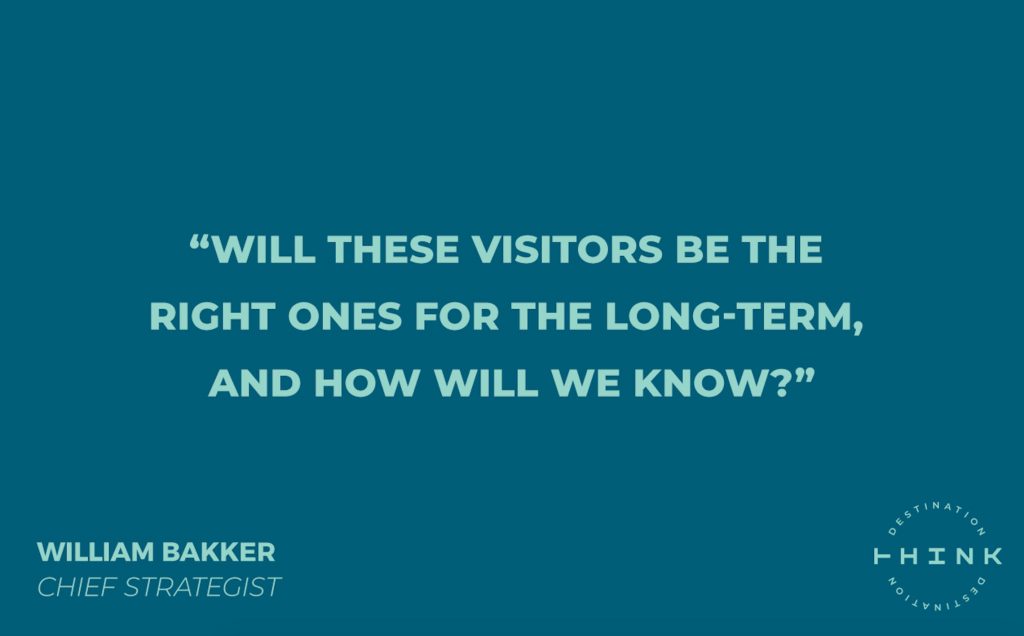COVID-19-related regulations are probably causing your destination’s travel markets to change. But are your newest visitors the right match for the long-term? Our Chief Strategist shares his thoughts on how your DMO can mitigate the crisis by balancing short-term fixes with investment toward longer-term travel markets.
Right now, your destination might be cut off from your typical, reliable travel markets. This problem stems from necessary COVID-19 restrictions and the resulting changes to travel behaviour. Even if your borders reopen tomorrow, the growing preference for local experiences and the move away from long-haul travel may have long-lasting consequences on who visits your destination. How can you adapt?
Short-term solutions
Don’t assume that new markets will know how to behave.
“Avoid the assumption that new markets should know better.”
Forced to look elsewhere for visitors, many destinations have focused on the domestic market, earning mixed results. There are valuable lessons in observing how places cater to near-in visitors. For example, in South Australia, a campaign encouraging residents to explore the state was well received. Focusing on wide-open spaces and remote nature getaways, many of the accommodation offerings featured are booked out well into 2021. Yet the influx of domestic travellers into the state’s smaller communities has not been without problems. On the Eyre Peninsula, new signage intended to inform the drive market of a picturesque monument angered some residents. More than wanting to keep “local spots for locals,” many cited the risks of encouraging people to explore a location that is known to be dangerous.
For our Chief Strategist, William Bakker, this scenario underlines the need for DMOs to educate all new visitors and keep an eye on the future. “Avoid the assumption that new markets should know better,” he says. This will ensure visitor benefits pass onto the local tourism industry without negatively affecting quality of life, the environment, or visitor safety.
Provide visitor education to all new markets.
“When you visit someone’s house, you respect their rules. Visitor education does the same by showing that you have a responsibility when you travel.”
Many of the specific challenges destinations face this year result from people visiting unfamiliar environments. For example, first-time hikers in the Italian Alps or Colorado or those new to camping in Canada have lots to learn. William recommends ramping up the educational component. The Leave No Trace initiative, adopted by many DMOs, including Destination British Columbia and Destination Campbell River, educates visitors throughout the customer journey. From social messaging to in-destination signage, the traveller is well and truly aware of the rules when they visit and can pass on that knowledge to others.
New visitor education is an ample opportunity for places that have learned they are too reliant on faraway markets. It accelerates a trend that is already happening in places like Palau, New Zealand and Copenhagen, where visitors pledge to be respectful and mindful — ultimately leaving a positive contribution to the destination. William puts it this way. “When you visit someone’s house, you respect their rules. Visitor education does the same by showing that you have a responsibility when you travel.”
Long-term solutions: New market research into wider markets
“Take time to pause. Don’t assume new markets are the same as the old ones.”
As restrictions gradually ease, your DMO may find an opportunity to target a wider pool of visitors. You’ll be tempted to turn back to your traditional, pre-COVID markets, perhaps alongside niche markets and other marketing considerations from before 2020. William’s advice? “Take time to pause. Don’t assume new markets are the same as the old ones.” Destinations need to conduct current market research that reflects our new reality. “Study new markets through the lens of the customer journey to match your new visitors with the right experiences in your destination,” he says.
Beyond new market research, William urges all DMOs to keep an eye on the future. Save and share this graphic as a reminder for your team:

Traditionally, DMOs define the right visitor in economic terms – the person who spends the most money. But your DMO needs to redefine what the right visitor is, says William. “The right visitor might spend less money overall, but they’ll spend it on things that benefit the community, such as dining at locally-owned restaurants, attending a community gallery or avoiding specific tours and chain hotels that contribute to tourism leakage. They will enjoy activities that aren’t disruptive to the environment. Their values will align with the host community.”
Ultimately, this is about defining what success means for your destination. With a clearer, co-created definition of successful tourism, you can lead the restart in a way that reflects what your community needs most.
Feature image credit: Viktor Talashuk, Unsplash









The last paragraph makes a very good point and should be heeded by destinations looking for the ‘high value client’. This definition of target segment should not the same as ‘ high net worth’ visitors who may want luxury but not necessarily a local experience. The term ‘high value’ needs a clear definition by the DMO and should be in agreement with the values of the community and it should benefit both visitors and residents.